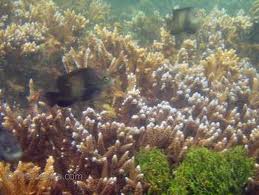 |
Home About Directory Conservation |
 |
Weligama Reef Location: 50 58’ 15 N and 800 25’ 15 E to 50 56’ 15 N and 800 26’ 25 E; 659554 N and 435438 E to 655867 N and 437279 E; at the western end of the Weligama Bay at Kapparatota, in the Matara District, of the Southern Province. Area: Reef area unknown Altitude: Sea level to a depth of around 6m Overview: The Weligama reef is an important shallow fringing coral reef habitat located along the southern coast. It was once considered to be one of the best coral reefs along the southwest coast with a live coral cover of over 80%, but has since been severely degraded by both human and natural impacts. Weligama is an important fishing area and the reef is important for the collection of ornamental fish species. Physical features: The reef contains a shallow reef crest and inner reef lagoon with an outer reef slope containing a spur and groove formation to a maximum depth of around 6m. The outer reef slope is exposed to high-energy conditions and has a low coral cover dominated by encrusting corals. Coral patches varying in size from a few meters to over 30m across are scattered throughout the reef lagoon. The depth within the reef lagoon varies from 1m to around 3m. The reef is influenced by the southwest monsoon from May to October, which results in rough seas, although calm conditions tend to prevail throughout the year within the sheltered reef lagoon. Sea conditions are best between November and April. Weligama lies within the wet zone of Sri Lanka, which is characterized by an annual rainfall of over 2,000 mm per year and a mean annual temperature of around 270 C. Ecological features: The inner reef lagoon contains extensive coral habitats dominated by branching Acropora spp. Significant stands of Montipora and Pocillopora are also found. There are extensive algal beds and significant sea grass patches within the reef lagoon dominated by Thalassia sp. Over 150 species of reef fish have been recorded from the reef, and the fish community is dominated by wrasses (Labridae) and damselfishes (Pomacentridae), including large colonies of territorial Stegastes spp. Several species of marine birds such as gulls and terns are also found around the reef area. The 1998 coral-bleaching event resulted in a decrease in species diversity of corals and fishes dependant on live coral. Currently, the live coral cover is around 32%. Noteworthy fauna: Among the reef fish, Chlorurus rhakoura and Pomacentrus proteus are restricted to coral reefs in Sri Lanka. The rare and protected Labroides bicolour has been recorded at this reef, while Carcharhinus melanopterus are occasionally seen along the outer reef slope. Two species of globally endangered marine turtles (Chelonia mydas and Lepidochelys olivacea) visit the reef. Noteworthy flora: There is a high diversity of marine algae within the reef consisting mainly of Halimeda, Caulerpa, and Sargassum. Seagrasses include Thalassia sp. and Halodule sp. Land use: There is extensive collection of ornamental fish from the reef, which is a major livelihood for the associated community. Some artisanal fishing occurs within the reef area. The reef lagoon is used as an anchorage for multi-day fishing boats Possible changes in land use: Continued degradation of the reef would possibly result in reduced live coral cover and reduced diversity of corals and reef fish that may affect livelihoods of fish collectors. Hydrological and biophysical values: The reef is part of a system of marine habitats within the Weligama Bay. The reef protects the shoreline from direct exposure to monsoon waves and influences the current pattern within Weligama Bay. Extensive algal beds act as sediment traps, and coralline algae such as Halimeda are major producers of sand. The shallow reef and associated sea grass habitats act as feeding and breeding grounds for a number of fish species. Social and cultural values: The reef is extremely important for sustaining local fisheries related livelihoods, which are traditional activities in the area. Scientific research and monitoring: Weligama reef is monitored by NARA as part of its long-term coral reef monitoring programme supported by the GCRMN and CORDIO. The University of Ruhuna has also conducted studies on the reef. Conservation education: NARA and IUCN have conducted education programmes for ornamental fish collectors in partnership with the Ornamental Fish Exporters Association of Sri Lanka. Recreation and tourism: There is limited tourism within the reef, which is visited by tourists staying in nearby hotels. There is a PADI dive centre at the Bay Beach Hotel located adjacent to the reef, which conducts SCUBA diving tours. Conservation measures taken: Information not available Conservation measures proposed: Weligama Bay has been proposed as a SAM site by the CCD. Disturbance and threats: Fish collectors have degraded the reef especially through the use of the illegal moxy nets and other destructive techniques. Corals have also been damaged due to the anchoring of fishing boats within the reef lagoon. Extensive coral bleaching in 1998 resulted in live coral cover decreasing to around 20%, and although many corals have recovered, the species diversity is low. The reef was also impacted by the December 2004 tsunami, which resulted in some loss of live corals. Extensive collection of targeted fish species has resulted in reduced abundance and diversity of reef fishes. Need urgent actions to mitigate existing threats. Land tenure: State owned Management authority and jurisdication: The reef lies within the coastal zone and is therefore under the jurisdiction of the CCD. The DFAR has responsibility in implementing fisheries regulations. References: De Silva (1985); Öhman et al. (1998); Rajasuriya (2005); Rajasuriya et al. (1995); Rajasuriya et al. (2006); Nishan Perera (personal communication) |
| Maps |